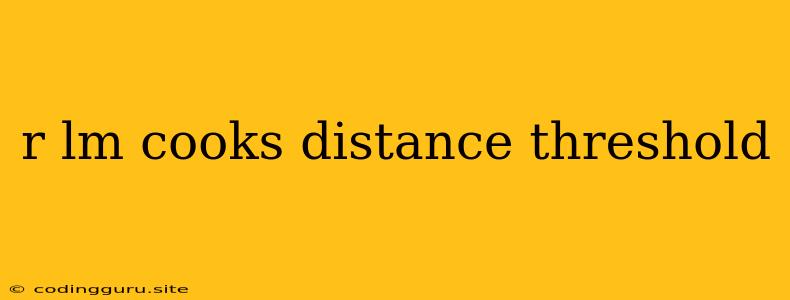Understanding Cook's Distance and Its Threshold in Regression Analysis
Regression analysis is a powerful tool for understanding the relationship between variables. However, it is crucial to ensure that the model is robust and not overly influenced by outliers. Cook's distance is a statistical measure that helps identify influential data points that can disproportionately affect the regression coefficients. Understanding the concept of Cook's distance and its threshold is essential for ensuring the reliability of your regression model.
What is Cook's Distance?
Cook's distance is a measure of the influence of a single data point on the regression model. It quantifies how much the fitted values and regression coefficients would change if that particular data point were removed from the analysis. A large Cook's distance value indicates that the data point has a significant impact on the model, potentially suggesting an outlier or influential observation.
Why is Cook's Distance Important?
Cook's distance is crucial for several reasons:
- Outlier Detection: Identifying influential data points helps you determine whether they represent genuine observations or errors in data collection.
- Model Robustness: Cook's distance helps assess the stability and reliability of your regression model. A model heavily influenced by a few data points might not generalize well to new data.
- Improved Model Performance: Removing or adjusting outliers can improve the overall fit of your model and lead to more reliable predictions.
How to Calculate Cook's Distance
Cook's distance can be calculated using statistical software packages like R or Python. The calculation involves:
- Fitting the Regression Model: Fit a regression model to your data without the data point in question.
- Calculating Residuals: Calculate the residuals, which represent the differences between the observed and predicted values.
- Calculating Cook's Distance: The Cook's distance is a function of the residuals and the leverage of the data point. Leverage measures how much the data point influences the model's fit.
Interpreting Cook's Distance
Cook's distance is typically represented as a numerical value. Generally, a Cook's distance value greater than 1 is considered significant, indicating a potentially influential data point.
**However, the threshold for Cook's distance can vary depending on the specific context and the number of data points in your dataset. **A good rule of thumb is to examine data points with Cook's distance values above 1, but it is important to consider other factors as well.
Setting a Threshold for Cook's Distance
Choosing a suitable threshold for Cook's distance is subjective and depends on several factors, including:
- Sample Size: Smaller sample sizes tend to have larger Cook's distance values.
- Data Distribution: Data with outliers may have higher Cook's distance values.
- Research Context: The specific context of your analysis might necessitate a more conservative or liberal threshold.
Visualizing Cook's Distance
Cook's distance can be visualized using scatterplots or plots. These plots can help identify data points with significant influence, making it easier to assess their impact on the regression model.
What to do with Influential Observations?
If you identify data points with high Cook's distance, it's essential to investigate them further:
- Verify Data Accuracy: Ensure that the data point is accurate and not an error in data entry or collection.
- Examine the Observation: Analyze the observation to understand why it might be influential. Is it a true outlier or a unique case?
- Consider Removal: If the observation is a clear outlier and cannot be explained, you might consider removing it from the analysis. However, this should be done with caution and only if removing the observation doesn't significantly affect the model's interpretation.
- Alternative Modeling: Explore alternative regression models that might be less sensitive to outliers.
Conclusion
Cook's distance is a valuable tool for identifying influential data points in regression analysis. Understanding its significance and setting appropriate thresholds can help you build robust and reliable models. By carefully examining data points with high Cook's distance, you can improve the accuracy and generalizability of your regression results. Remember, using Cook's distance effectively requires a combination of statistical understanding and domain expertise to make informed decisions about handling influential observations.
